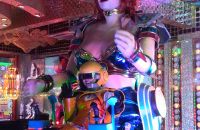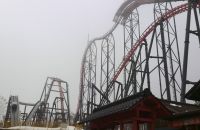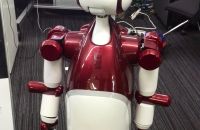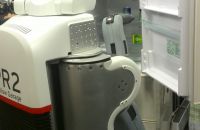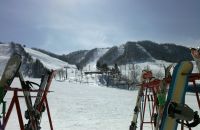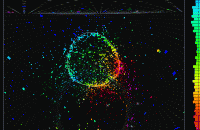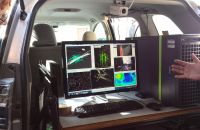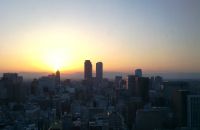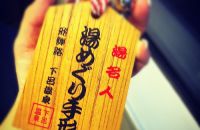Interesting trip it was, we saw a lot, walked a lot, talked a lot (and loudly), experienced and learned a lot. This study-tour will be spoken, thought and laughed about even weeks after everybody returned to the Netherlands.
Mixed feelings I would say. It has been three weeks which is a long time, still I have the feeling I’ve been there for months. Not because it was bad, solely by the amount of data throughput in my brain. Most of the time I could hardly remember what we had done the day before.
So no it’s time to reflect, while sitting in an airplane cruising over the snow white Siberian lands at 900 km/h. This morning most of us woke up at about 600 hours, took a shower and had some breakfast, where others just stayed in bed. Although it wasn’t a so called ‘Darwin’ process this time. For those who stayed in the bed the journey wasn’t finished. A few (3) would head to Vietnam that day, one to Cambodia and the rest (6) stayed behind in japan. I hope they enjoy their stay and may their trips help them recuperate from our last three amazing weeks. That’s all I’m able to say about them as I’m going to our (still) beloved Netherlands. (Fun fact: most people just know the Netherlands as Holland which is technically speaking incorrect.)
Smooth sailing is the correct term for the travel to the airport as I’ve seen the inside of my eyelids for most the time. Of course aware of every station we’ve passed making sure to get out on time. Dozing in a metro or a train is a feature acquired in Japan. The first two weeks I didn’t sleep/doze at all during our travels, but as one gets tired enough eventually everybody succumbs to nodding “knikkenbollen”. I believe that for every one of us there is evidence for that crime. The rest of the trip will be devoted to staying awake, because we will arrive in Enschede at about 2300 hours.
It’s a shame we have to wait about two and a half hours at Frankfurt before flying further to Schiphol. We took off at 700 hours from our hostel at this moment it is about 1330 hours and we already traveled as long as thirteen and a half hours. And at the moment of writing we just left St. Petersburg behind and are above the gulf of Finland. Still a long way to go before arriving at home.
Frankfurt of course is a whole different story. In Japan we joked around about the post-japan trauma we might get. It really was no joke at all. Walking with my luggage to our gate I tripped over three people, the moving walkway was clogged by people standing in the middle. It was a nightmare, why couldn’t people just walk straight or stand at one side of the moving walkway?? Fortunately we got to our gate uninjured and got on with our final flight to Amsterdam. Which was not interesting at all, taxi from landing until we arrived at the gate on Schiphol almost took longer than the entire flight from Frankfurt to Amsterdam.
As expected we all got our luggage quickly and arrived at the train station in time to get a train earlier than planned (with a switch in Amersfoort). Still thinking about the train system in Japan which was (except for the first day because of heavy snow) flawless, our train arrived fashionably late with a delay of 5 minutes. Then there was the problem that we didn’t know where the doors would open. We were clueless and already missed the Japanese system. We all got on the train with reluctance, questioning ourselves… why did we leave Japan?. 5 minutes is not that much I must agree, but as we progressed the delay got longer and longer. At Hilversum the delay was about 15 minutes, on a route which shouldn’t take more than 45 minutes. Our chance to get the switch at Amersfoort was lost. So we got out of our train and waited there for the train we had planned to take in the first place. After running for a vending machine at the other end of the station we all got on the right train straight to Enschede. After staring out the window for a while we arrived at Hengelo, where it was the end of our journey together. We said goodbye to each other because I was the only one taking the bus. After the bus trip and a little walk, I got to my home. It was 11 PM, almost 24 hours after leaving the hostel. Wrecked, tired, amazed and maybe a little sad I went to bed. With the last thoughts about the hard matrasses and flimsy pillows in Japan I went to sleep…
Oyasumi nasai!
By: Eelco Bussink
Today we set out to find some cosplayers! Cosplayers are, mostly younger people, which set out to play their favorite manga character. These cosplayers really go the full nine yards when dressing up and every detail is taking care of. Unfortunate it was winter and the weather was not that good, resulting in the absence of cosplayers. We walked to several well-known places in Harajuku , like parts of yoyogi park, but did not see any manga imitation. So slightly disappointed we were wondering around the streets of Harajuku where there is a 200 meter queue for a popcorn restaurant.
After harajuku we travalled to akihabara to visit electric city. We were told that some there would be some cheap Apple products and indeed some of us purchased an Apple TV for 75% of the European price. After visiting the giant electronics shops in Akihabara we gathered at our hotel to go out for diner.
Diner was going to be served in a so called ‘robot restaurant’. We didn’t really know what to expect, but we did know that there were robots and beautiful girls involved and that we were not allowed to wear sunglasses, have tattoos or get drunk. This show turned out to be, by far, the most epic show and climactic spectacle we visited in whole of Japan.
When we got to the restaurant there was a robot band playing live music while we were waiting to get our tickets. This first waiting room contained several million LED’s and almost as much mirrors. After we got our tickets we went to the second waiting room, where drinks were served. This had even more LED’s and shiny objects all over the place. We had a beer and because of the chaos a large group inherently imposes we managed to get a free beer at our table. This evening was the last evening of Wim, so he gave a really inspiring speech. Now it was time to enjoy the robot show. We went down and got a Bento box, which contained some fish and meat, and took place on one side of the room. The show began and was a show full of hot girls and robots trying to tell a story. The show even contained kung fu panda riding a cow and a mermaid riding the back of a shark, which at his turn ate the robot enemy. The show lasted about 1,5 hour and was completely filled with action and live music.
In short: we couldn’t wish for a better closure of our study trip than a show about robots and scarcely dressed women. We can look back on a very successful study tour where we managed to get on time at almost every company, even when we used local trains and busses for the first time, and where we saw a wide variety of different companies and institutes. This was only achieved by a dedicated group of young engineers that were motivated to get the most out of a study trip to japan.
By: Ingo stijntjes
Yesterday we have visited the last two companies of our tour. We ended that day with a Cantus. Today we had one hour more sleep in compare with the previous two days. It seemed that no one was suffering from a hangover. This day is the second last day of the study tour and is used for cultural activities. Around half past eleven we arrived at train station of Fiji-Q Highland in Yamanashi. Fuji-Q Highland is an amusement park near the base of Mount Fuij. It has for example a number of roller coasters, as well as two haunted attractions.
We get the choice to visited the park or doing something else in the district. Half of the people went to the park, some people went to the Mount Fuij and Erik, Jasper, Frits, Ray and I went to Saike Lake. This was one station further than the station of the park. Saiko Lake is the one of the Fuji Five Lakes and is located in southern Yamanashi. Around the lake there were different kind of activities for example museums and caves. A special bus line drives around the lake. We bought an one day ticket for this bus line. We went to the Nenba area by bus. This area is located on the North West of Saiko Lake. It had been a dignified settlement with thatched houses of “Kabuto-zukuri” (roofed like samurai warrior helmet), until a typhoon in 1966 hit the area seriously, and devastated the village. But after more than forty years, the old-time scenery of thatched roofs with Mt. Fuji in the background was revived, as “SAIKO Iyashi no sato NENBA” was born, rooted in the region's history, culture ant he natural environment.
We have visited some of the houses in the village. Inside most of the houses were works of art to see. But in the last house we visited hung a lot of kimonos and samurai suits. For 500 yen you can wear these suits and make pictures of yourself. So we decided also to wear these samurai suits. Two little people helped us to attract the suits. We went outside as five samurai warriors employed by the Japanese emperor. We have taken a lot of photos and movies from ourself. Frits looks more as a wizard than a samurai warrior.
After that we changed the clothes and we tried to take the bus. But the bus of the special line was already gone. So we took the local bus back to the station. Near the station we have dinner in restaurant which had a overview at Mt. Fuji. But it was a misty day so we saw nothing.
After dinner we took the train back to the hostel and we spent the last few hours of the day in a bar near the hostel.
By: Karim Kok
Today the last company visits were made. It was a great with lovely weather. The day started with Jelmer being late because he had to explain to the lady of the hostel how one of the Australian guests was arrested that night. In a drunken mood the Aussie had bothered a karaoke bar. Luckily Jelmer could explain to the police men that he and Eelco had nothing to do with it and had actually calmed down the drunk Aussie.
The first company visited that day was Asahi Kasei Microdevices or AKM. Asahi is also one of the beer brands in Japan but this company develops and produces chips for certain niche markets. In several of this niche markets AKM is market leader, for example the market of electronic compass chips.
Next up was Waseda University were we visited the department were human-symbiotic robot systems were researched. This department made the first humanoid robot in 1973 called Wabot-1. Waseda University had a most interesting philosophy: "Realization is important, theory or simulation alone is not enough". They demonstrated this in their various setups where they used "Humanoid robots as human partners, humanoid robots as human simulators". The most interesting robot demonstrated was Schema, a robot to enhance conversations. It monitored the emotial state of the participants of a conversation and tried to involve participants that were left behind in the conversation. Because it had to make an enjoyable conversation the robot was incapable of saying negative phrases.
To finish the day and celebrate the the end of the company visits a Cantus Scintillae was held in a karaoke room. During this cantus the events of the study tour were discussed. This mainly involved the people that were 'darwinned' or people who had done some exceptional work for the study tour. All in all a great way to finish the company visits.
By: Erik de Wit
A day of snowboarding and skiing, followed by 5 hours of sitting in the train makes it quite a challenge to get up at 6 the next morning. Today we are going to visit NTT and Tokyo university.
NTT is like the KPN of Japan. They provide telecom services and besides that also have quite some impressive research laboratories. First we get the standard intro talk about the company, where they are located, their structure and the research they do. After these formalities it is time to visit some labs. First off we go to a cryogenic lab in which they experiment with equipment at 20 mKelvin which is pretty cold!
The second lab we see was working on single electron transistors. They tried building a full adder with it. Using single electrons means very power efficient and small devices.
At the third lab we finally figured out what all the aluminum foil is for that covers the large MBE machines. These are giant metal structures in which all kinds of chemical processes take place to deposit layers of atoms on wafers. When cleaning out the machine, which is made of stainless steel, it has to be evacuated. This means exposing it to normal air instead of the vacuum that is usually inside. When this happens water droplets tend to stick to the inside of the machine which is unwanted. To resolve this the machine is heated, but because steel is a poor conductor it is wrapped in aluminum foil to help the process.
After our tour at NTT we took the train again to go to Tokyo university. The planning was pretty tight which meant no time for lunch and running through the stations to get there in time. When we finally arrived we had to find our way through the maze building with double numbering on the doors. A bit late, but at the predefined location the intro presentation was skipped and we started with the lab tours immediately.
Tokyo university had a lot of robots to show off which was very cool. First they showed a humanoid robot which could open a door. As the law of Murphy and the demonstration effect predicted this of course failed the first time. When the robot grabbed the door handle and pulled it open it somehow tripped and made itself fall over, because it had no stability control other than keeping its center of gravity above its feet, which doesn't work when you're falling. On the second try the robot got it right though and opened the door successfully. In the same lab was also another robot that opened a refrigerator and handed Erik a drink. Pretty cool to see.
The second lab showed an even more human like robot which had tendons and everything to simulate muscle movements. The engineers working on it tried to make it ride a bike. Some more interesting research was shown including a hydraulic setup with force feedback which could also simulate muscular movement and was very powerful and fast.
Another one of the setups was to digitally simulate the human body and all the muscle movements. They showed us a computer model of the human skeleton with all the muscles drawn on and this model was linked to the movements of an actual person who had passive markers on his body and about 16 cameras watching his every movement from every angle. The model could move in real time and show the muscle movements.
There were a lot more robots and research being done into various applications, but because we had a limited time we couldn't see everything.
The predefined schedule for today ended and everyone had the rest of the evening to themselves. With a small group I started to head back for the hostel. We made a stop at one of the intermediate stations to find a nice place to eat and ended up in some kind of Indian restaurant where they served a pretty good curry with a large piece of naan bread. Feeling pretty stuffed we took the next train and went back to the hostel to get a nice and long night of sleep.
By: Mattanja Venema
Today started early again because it was time to ski! At 8 AM we had to be ready for skiing, this meant we had to be in the hotel lobby with our bags and appropriate clothes for skiing. Our bags were stashed in the lobby because we had to check out, as today is the day we travel back to Tokyo for the final days of the study tour.
At 8:15 AM some people were still missing, so Rowan, Frits and I (Tim van Doesum) went to the bus station to obtain and pay the reserved combination tickets. Those tickets combine a bus round trip ticket with a day pass for the ski lifts at the ski resort. When returning to the hotel with the tickets the group was ready to leave except for Ivo and Roelof who were still inside. Roelof had already been spotted, but he had gone back to Ivo's room to tell him to hurry. However Ivo had already decided that he would stay behind in Takayama for the day as he didn't want to go skiing. The group left for the bus station, next to the train station which is only a few minutes walk from the hotel. On arrival Roelof had caught up, luckily, as he was the group leader for the day.
At 8.40 AM the bus to the Honoki hida norikura north alpine ski resort left, the bus took about 50 minutes to get there through stunningly beautiful snowy mountains. It was a very nice day as the sun was shining brightly and there were almost no clouds in the sky. When we got to the ski resort we discovered there were two shops for ski and snowboard rental, so the group split in two to get ski's/snowboards faster. Karim had some difficulty obtaining ski's as his shoe size wasn't available at the ski shops, fortunately they found some big ski shoes after searching a bit more. Because of this one group finished a lot faster than the other and already went onto the piste to practice skiing. For some people this was the first time they went skiing, this includes me (Tim van Doesum). Robert had to wear the Pikachu suit today as he did not show up for one of the company visits earlier in the tour, Pikachu on ski's got a lot of attention from local skiers.
Of the people who were finished early at the ski shop only three hadn't gone skiing before, Roelof, Pikachu (Robert) and myself, so we practiced a bit at the starting area. When Jens and Frank joined us we went up on the hill with two ski lifts and they taught us a bit more about skiing. I picked it up quite quickly, Pikachu and Roelof had some more difficulties. After practicing with Erik, who was also skiing for the first time, I finally completed a piste without falling. After a few hours skiing we had lunch at a restaurant at the base of the ski pistes. Erik and Jelmer had a very big bowl (probably about 1 liter) of miso ramen (noodle soup), I myself had fried chicken with rice, it all tasted very good. Jelmer told us he had fallen on his arm in a nasty way when he was snowboarding so he was done for the day. Erik and I went back up the mountain, this time I took my photo camera with me to take pictures as it was still a day with blue skies and a bright sun. The view at the upper station of the second ski lift was really very nice.
After skiing a while longer I started to feel that my muscles were getting tired so I decided to stop, at that point it was about 2:15 PM and we were told to gather at 3:15 PM. This gave me some time to enjoy the sun. A lot of people got sunburnt today, especially in their faces, Frank was wearing a Japanese headband and it is clearly visible where he wore it.
At 3:15 PM we all gathered to take the bus back, and we concluded that everyone had survived the day in good health! After another 50 minutes bus trip we had about one and a half hours time to have dinner. At 6:45 PM we took the train from Takayama to Nagoya. This was a trip of about 2 hours, after which we took the Shinkansen from Nagoya to Tokyo (also about 2 hours) and finally we arrived at the Anne hostel in Tokyo at 23:30 PM.
By: Tim van Doesum
After a long night of sleep at our new hotel in Toyama, we took a delicious and extensive breakfast. Besides fish, rice, sweet croissants and yoghurt, there was also a wide variety of fruits and vegetables, which was nice, as most of us where almost getting scurvy. It was great to see that everyone made good use of the weird clothes that were provided by the hotel. Especially the socks, that were looking like camel toes were fun to see. Of course I made some photographs of me and my breakfast. If you would like to see them you can contact the organization of this tour.
At 10:30 AM we started our journey to the Kamioka observatory, where a neutrino detector was waiting to reveal its secrets to us. On our way in the train, the view was amazing. Snow covered the mountains and the trees, small lakes and streams were appearing and disappearing everywhere I could look. It was almost as if we had stepped through the wardrobe and reached the magical realm of Narnia. It was even snowing for a while, which promised good snow conditions for some skiing. Unfortunately most of us were sleeping. For some people, apparently the long night wasn’t long enough. Anyway, after a long train journey, during which I took a lot of photographs, we reached Inotani station, where a small but cosy bus was waiting for us already. The bus was specially arranged for us and therefore had a sign in the front with the text ‘Study Project Sakura Zensen’ on it. Of course everyone had to take a picture of it, so I guess that we have 23 times the same image. During the bus trip, everyone was discussing about neutrinos and what they actually were, while I was making a lot of selfies. I can say that I have acquired quite some skills for this ingenious way of creating photographs.
When we finally reached our destination, we had to take our shoes off. Luckily, the bad smell from everyone’s feet was soon masked by the nice smell of food. Even though I was still chewing on my breakfast, it was time for a lunch! After this great, big lunch it was time to feed our brains and we could finally learn what a neutrino actually was. There was a nice and informative presentation about the neutrino’s, why they have mass and how they are detected. Unfortunately, since we don’t have a physics background, the talk was hard to grasp for most of us. However after the presentation we received a helmet and went into the observatory to see if we could understand a bit more after seeing the detector. Here the real excitement began. We went a kilometre under the ground in the cosy bus that I mentioned before. Of course I had to take some selfies, while I was wearing my helmet in the bus and in the cave. When we reached the Kamioka observatory, we were welcomed by a friendly, somewhat bold and somewhat big American, who was wearing a big Hawaiian blouse. He immediately received our attention with his nice and funny stories. He began with a story about some of the doors inside, on which several ‘famous’ people had written and a story about the emperor of Japan, who also visited the observatory. The man told us about all the rules and formalities regarding the emperor’s visit and about how the emperor didn’t want to wear a helmet, since he ought to be the boss of the mountain god. Next he told us about a ‘little’ mistake the engineers made during the creation of the Kamiokande. The photon detectors in the Kamiokande, which where hand blown by specialists, to obtain the high precision (they can detect up to a single photon), were not able to withstand the high pressure, resulting in 23 million dollar damage when they all exploded a few years ago. This man was really full of stories. After a few of them we finally continued our walk to the Kamiokande detector.
There were we, on top of the detector, a big spherical shaped cave with a height of about 50 meters appeared above us and only 5 millimetres of stainless steel was between our feet and the purest water in the world with which the detector was filled. Of course our guide was again entertaining us with his informative yet funny stories about the detector. The water was apparently so pure, that it would literally dissolve a human being after falling into the water. In stead of a wetsuit, divers had to were a special dry suit when they entered the water. After a group picture, the observation of some computers and electronics and about thousand funny stories from our guide, our ‘photographer’ told us that we had to leave. However the guide was still busy with his stories and just ignored the poor lady. He was just talking about Gadolinium, an element that he was very fond of, because he wanted to use this element to detect supernova neutrino’s. He once tried to carry a box of this element with him while traveling by plane. As the material was white and powdery, it raised some questions at the border security. When he yelled “Wait, don’t open that, it’s very pure!” he came to the conclusion that this was a bad idea and spent a long time in the interrogation room.
After visiting the Kamioka observatory, we said goodbye to Sander, one of our supervisors. He said thanks to everyone during a nice speech. At our hotel we had a nice diner, during which the waitresses got very shy and giggly because of our attention. Today was a good day.
By: Frank van der Hoek
Our last day in Nagoya started early: at 7:30 everyone gathered in the lobby of Hotel Wing International accompanied by their luggage. Before leaving Nagoya we still had to visit the Toyota Technological Institute and a company called Ubukata.
The Toyota Technological Institute (TTI) is the smallest college of technology and science in Japan. This college is founded with the aid of Toyota Motor Corporation, but operates independently. Like other companies in Japan, Toyota wants to contribute to society by supporting this institute for top-level research and education.
We were welcomed by Hiroyuki Sakaki, president of TTI. He explained the history of Toyota and the Technological Institute. In only 30 years of existence, researchers at the institute won several Nobel prizes. They aim to learn students the important basics, but they also develop social aspects, learn about society and humanity and gather practical knowledge during several internships. The tour took our group along the Smart Vehicle Centre, where some small electrical research vehicles are used to develop autonomous driving cars. The Smart Vehicle Centre also has a real car equipped with sensors and all the necessities for autonomous driving. Another part of TTI we got to see focussed on materials for photo detectors. In this lab detectors could be made out of different materials and afterwards characterized. This contributes to the development of new designs and the use of new materials. After a nice informal talk during lunch we had to leave TTI and go to our next stop: Ubukata.
We had found this company on the internet and contacted them to arrange a visit. Ubukata produces several products to enhance safety in home and for the automotive industry. It was founded in 1957 and currently has 210 employees. The products they make are seismic sensors, motor protection devices, thermal switches for automotive air conditioning, glass terminals for cable feed through and a new line of consumer earthquake sensors. Their seismic sensors are used in 70% of the Japanese homes to shut off the gas supply in case of a strong earthquake. The motor protection devices are mainly used in air conditioning compressors (global 70% market share) to prevent fire if the electric motor fails. Both products are a nice example of the company motto: “safety technology for all around the world”. During the tour through the factory they showed the production of bi-metal parts for the motor protection devices. All production machines were designed and build by Ubukata. This way, they are independent from other companies and have exact control of the quality of the end product. Not one single machine is the same because of constant improvement of the design.
After this visit we had to return to the hotel in Nagoya to collect our luggage. Then we took the train to Takayama, a trip of 2,5 hours. When we got out of the train we were surrounded by mountains and snow. Clearly we found ourselves in the Japanese Alps.
The presentations of both TTI and Ubukata also highlighted some cultural aspects that differ from the Netherlands. First, both speakers were very impressed by the way this study tour was organized. Organizing this tour is a very good opportunity for students to gather new competences and learn from other countries. Japanese students are often not in the position to organize a trip as we did, although both speakers emphasize on the importance of international experience. At TTI there is a special international room where you can talk in any language, except Japanese. Students from Japan and other countries can meet here and enjoy cultural events from other countries.
Secondly, the people at your company/institute are most important. Ubukata opted to build a new building at the location of the older office, instead of moving to another location. The latter option is cheaper, but came with the risk of losing employees who did not want to travel to the new location. The complete third floor of the new building offers facilities for the employees to use during break or after work. Every year a poster is made with the company’s main values surrounded by pictures of all employees, to show everyone who contributes to the success of the company. Both TTI and Ubukata stimulate people to develop new original ideas. Try to realize your dreams is key to Ubukata’s policy, or according to TTI: “Open the window and discover that the outside is much broader than you expect”.
By: Mark te Brake
Today was the first night I slept at the Nagoya Wing Hotel. The night before I stayed at a capsule hotel after a long karaoke session and some drinks in a small bar.
This morning we decided to have breakfast at the hotel, since we were a little bored with the rice balls and bento boxes from the 7eleven. The breakfast consisted of an English breakfast and Japanese food. It was ok, but not really that special.
After breakfast we were picked up by students of the Toyota Technological Institute. They were asked by their professor Hiroyuki Sakaki, if they could show us around that day. First, we went to the Toyota Commemorative Museum of Industry and Technology. The museum was really awesome. They exhibited all kinds of looms, which were used by Toyota in the past. Most of the looms were still working and were demonstrated to us. Besides the ingenious constructed looms, they also exhibited parts of the automatic production line that are used for Toyota cars.
Next we had lunch near Nagoya castle. Almost everyone ordered Hitsumabushi, which is barbecued fish on rice with some kind of miso soup and several toppings for the rice. The idea is to mix the rice with the toppings and add some hot soup over everything. Delicious!
After the great lunch we visited a theater/museum. Unfortunately, there were no shows when we visited, but the building itself and the exhibitions were beautiful. It also smelled really nice, because many parts were constructed of wood, which released a subtle fragrence.
Finally, we visited Nagoya castle. The castle was destroyed in the second world war, but they rebuilt it from scratch. The outside of the castle looked really authentic, but when we went inside, you could see it was reconstructed in an ingenious way. Since there was not much to see inside the castle itself, we went to a park nearby. There we saw part of a Japanese samurai show. I was expecting a lot of sword fighting, but it was mainly talking and making jokes. My Japanese is not good, so we left rather quickly.
Before we went to the final excursion of the day, we went to pick up Wim and Bram who are our new supervisors for the final week. We then went to the electricity museum. Although the idea of the museum was fun, the average age was around 5 to 10 and all the exhibitions were focused on that group. So that was the end of our official programme for that day. However, it was only 16:30 and we still wanted to do something and therefore we went on our own to the Nagoya TV tower were we had a fantastic view over the city during the sunset.
By: Ray Tanuhardja
Today we finally had a full day off. And we could look forward to a day of soaking in the well known Japanese Onsen.
My day report starts at 0:00 of course, when we were doing our laundry, which we ran in the dryer for three times without the desired result. Between the washing sessions we enjoyed some drinks and a few games of Fluxx. After carefully hanging the laundry at every possible location, me and my buddy Frank shared a small sized bed and spooned until the crack of noon.
After sleeping in we took a train to Gero, a well known spa village. During this trip of 2,5 hours most of the time was spent by playing cards or sleeping some more.
Goal of the day was relaxing in traditional Onsens! We obtained a wooden block with three stickers and a bell attached to it which represented our entry ticket. An Onsen is a Japanese bathing place where you first wash yourself sitting on a small bench. You use a special small towel for this that you cannot soak in the hot baths because that will be unhygienic. To solve this problem every guest places this towel on his head while bathing. We follow the locals example and got into the first bath. All water comes from natural springs and is heated by geothermal energy. This pumps the temperature of the water to very high levels and some baths are a challenge to stay in to.
Gero is also known for its many foot baths it has randomly scattered across the village. We used one with some locals. Our group did not manage to use all three stickers in one day, we have still one left, but it is valid for half a year, so a good reason to come back!
Half an hour before gathering for the trip back we got to the same Chinese restaurant where we had lunch earlier to have a high speed diner. Within 20 min we had eaten and joined the rest of the group.
For the trip back to Nagoya we bought some beer and played cards. We were fully recharged to go and explore the night life of Japan. With a small group including two professors we went out. We inquired with the hotel staff where we should go and they recommended a nice pub where we drank some beers. After the usual 'pingel-bets' (these are 1¥ bets mainly about random girls in the pub) we went out to go to a club. When we walked down two streets we found ourselves entering a scene of the fast and furious Tokyo drift. There were dozens of tuned cars running down the streets with a lot of people cheering. One of the cars found it necessary to plant his car into a concrete block which resulted in more cheering and laughing. It was really a big happening and after talking to some locals we learned that this was a weekly event.
We resumed our trip to a club and found a club called 'Flamingo' which looked like a gay club, so of course after some doubt and bargaining on the entrance fee we went in. In this process we lost one of our mates, and after a short search and rescue we pronounced him Lost in Action.
The club was everything but a gay club, luckily, and there was a good man to woman ratio. The music included some 'normal' songs mixed with some up-tempo J-core crap. We immediately came across a small group of ladies with who we enjoyed the rest of the evening. It was a very fun and cultural day and in the end even some of the Spockers managed to get a real taste of Japanese..
By: Ingo Stijntjes

